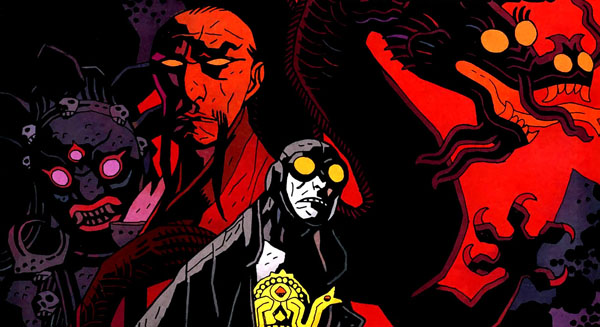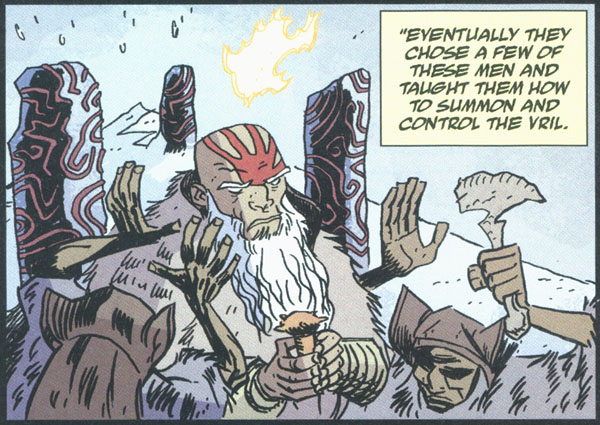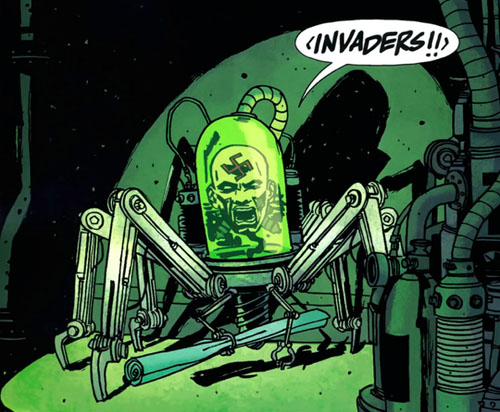
The Great Hellboy Re-Reading Project Part IX: The Iron Prometheus & Others!
Over the last several months I have undertaken an epic project: re-reading Mike Mignola’s complete Hellboy saga from the very beginning! What began as a series of sporadic mini-series and short-stories featuring the big red occult investigator has deepened over the past twenty years into what is, for my money, the richest and most consistently entertaining comic book universe of stories out there. Click here for part one, in which I discussed the very first Hellboy tale: the four-part mini-series Seed of Destruction. Click here for part two, in which I discussed The Wolves of Saint August, The Corpse and the Iron Shoes, and Wake the Devil. Click here for part three, in which I discussed a variety of Hellboy short stories including The Right Hand of Doom and Box Full of Evil. Click here for part four, in which I discussed Hellboy’s last mission for the B.P.R.D.: Conquerer Worm. Click here for part five, in which I discussed the beginning of a series of B.P.R.D. spin-offs and a whole new expansion of the Hellboy universe: Plague of Frogs. Click here for part six, in which I discussed the major shift in the Hellboy story that took-place in The Third Wish and The Island. Click here for part seven, in which I discussed the incredible B.P.R.D. mini-series that became the new central focus of the continuing Hellboy saga. Click here for part eight, in which Hellboy finally returns to the spotlight with Darkness Calls.
Following Darkness Calls, we got three mini-series that explored supporting characters in the Hellboy universe: Lobster Johnson: The Iron Prometheus, B.P.R.D.: 1946, and Abe Sapien: The Drowning. These mini-series might have been disposable, but to my delight each wound up being hugely important in the larger Hellboy epic. I will discuss each of them (and a few other stories!) below!
Lobster Johnson: The Iron Prometheus (2007) — I didn’t think too much of The Iron Prometheus when I read it the first time back in 2007. It seemed like a fun but ultimately irrelevant adventure of the pulp vigilante (who had been such a fascinatingly mysterious part of Wake the Devil and who had just recently re-emerged, in spirit-form, in B.P.R.D.: Killing Ground). But over the years I have grown to understand what a HUGELY IMPORTANT story Iron Prometheus is. It’s one of the most important Hellboy universe stories ever published. We get so many incredible pieces of the puzzle here in this adventure!!!
The series opens with Jim Sacks, who is carrying a prototype Vril energy suit. We saw photos of this in the scrapbooks that Johann found back in B.P.R.D. The Dead #3 and B.P.R.D.: Garden of Souls #2! Jim is attacked by a were-beast creature, but he’s saved by the Lobster. That creature feels like just a random type of monster/creature, of which we’ve seen so many over the course of all the Hellboy adventures. But this were-beast is in service to Memnan Saa, and we’ll see were-beasts in service to Memnan Saa again in B.P.R.D.: The Black Goddess!! (Only in The Black Goddess, they’ll seem like good guys.) It’s an awesome, super-subtle connection.
Speaking of Memnan Saa, I just love this method of developing the backstory of this character. We’ve seen this creepy, mysterious guy popping up in Liz Sherman’s dreams for several B.P.R.D. mini-series now. He seems to be trying to help Liz gain awareness of the true scale of the threat the B.P.R.D. is facing, which seems good, but he nonetheless feels untrustworthy. That Lobster Johnson’s ghost shoots him at the end of Killing Ground reinforces that (since, so far, we trust the Lobster). But to this point we still don’t even know his name, let alone his story or what he’s up to. And so it’s here, in a Lobster Johnson series set back in 1937, that we learn more about this guy. (Like his name: Memnan Saa!) This is just an awesome, sophisticated approach to story-telling, spreading the clues across various mini-series focused on different characters, and set in entirely different time-periods, and letting the audience make the connections and put the pieces together. Wild.
The Iron Prometheus doesn’t answer all our questions about Memnan Saa, but it gives us a lot of juicy info. It’s staggering that this “yellow menace” classic style of pulp villain — so appropriate for a Lobster Johnson pulp-inspired adventure tale — is going to evolve into the guy menacing Liz 70 years later. In those B.P.R.D. mini-series, he seems to be almost made of snakes. Not so here, he’s clearly a man, though we do see that he seems to have control over and/or a connection to snakes, as in #2 he turns little snakes into huge creatures that give the Lobster trouble.
In issue #2, the Lobster fights a bespectacled bad guy called Dr. Waxman, who mentions the Cossaro brothers. Classic Mignola, giving us the end of the story first. Years later, we’ll read of the Lobster’s earlier conflicts with Dr. Waxman and the Cossaro brothers (in Lobster Johnson: Get the Lobster). Also in issue #2, Memnan Saa warns the Lobster not to cross him, and to go back to his war against gangsters and spies. We then get four intriguing panels that hint at the Lobster’s future. We definitely see the Lobster fighting Neferu (which we’ll see years later in 2012’s Lobster Johnson: The Prayer of Neferu). Very cool. In issue #3, Memnan Saa says “the goddess” (does he mean the Black Goddess? Is this Hecate?) promised that the Vril would serve him. In issue #4, we learn that he wants to use the Vril to create 369 mutated “dragons” (the same number as the children of the Ogrdu Jahad — not a good sign). In issue #5 he reveals he wants to raise “her” (again, I think he’s talking about the Black Goddess, who the Hellboy Companion identifies as Hecate) from the dead (in Mr. Mignola’s awesome cover to #5, we see an image of the Black Goddess standing next to Memnan Saa), and he declares that: “Eventually I will look down on all the humbled nations of the Earth from my Hyperborean throne.” This feels like a standard bad-guy who wants to rule-the-world plan. Is that still what Memnan Saa is after 70 years later, or have his plans changed? Has he learned more, and become more altruistic? Or does he only want to prevent the destruction of the world by the Ogdru Hem so that he can rule it instead?
We also get, in issue #5, his intriguing comment that, if defeated, “I will slide out of the world again, make my plans, and return.” Seems like that’s exactly what he does!
In issue #3, Professor Gallaraga’s brain-in-a-jar (I love this comic) reveals some critical pieces of Hellboy universe back-story, filling in some of the pieces of the grand Secret History of the World that we began learning about in The Island #2. We see the Watcher, who created the Ogdru Jahad. We hear yet another reference to the “secret flame” and learn it is called Vril. (This Vril energy is what powers the Sledgehammer suit and is also the fire within Liz. See how everything is coming together?) We learn that Vril made Hyperborea a paradise, before it fell. We get more details of the fall: the people were worshiping the Black Goddess (who he refers to as Neb-Ogeroth, and who the Hellboy Companion identifies as Hecate). We learn that a few Hyperborean priests survived and taught the secret of Vril to a few humans — and we see the image of the priest with the red palm-print on his head, who we saw previously in The Island #2! And guess what, he’s holding the object that Liz will use to harness her Vril power in B.P.R.D.: The Black Flame. (Another awesome connection: the key to the Vril super-suit is an object called Anum’s Fork. Anum, as the professor tells us in #3, is the name of that Watcher who used the “secret fire” — the Vril energy — to create the Ogdru Jahad!!)
I’ve spent all this time talking about other characters, I should also discuss the title character himself: Lobster Johnson! It’s awesome getting to see an adventure of the Lobster in his prime. It’s cool to see his underground lair and get to know the Lobster’s gang. (Though, in hindsight, it’s all very sad because soon we’ll learn of the fate that awaits them all, only a few years away.) Speaking of the Lobster’s gang, is Harry, the blond guy in glasses, the same guy we saw back in that first Lobster Johnson short story, The Killer in My Skull? It’s interesting that we don’t learn ANYTHING about the Lobster himself, but I’m OK with that. I like that mystery around the character and don’t need to know any more about him.
The ending of this series left me very perplexed and a mite disappointed when I originally read it. Memnan Saa gets away and, what’s worse, the Lobster winds up apparently under the control/influence of the villain, unbeknownst to his friends! It feels like a weird anticlimax to this adventure, as the major bad guy gets away and the hero is stymied. In hindsight, I love this ending — it gives the whole story the air of tragedy. And since now, years later, we’re finally getting a series of Lobster Johnson stories set in the years before this, this story looms even larger in the over-all Hellboy universe tapestry. It’s shadow hangs over all those other Lobster Johnson adventures, as we know what’s coming, and that it’s not going to have a happy ending. Fantastic.
B.P.R.D.: 1946 (2008) — This is the first of what will become a series of mini-series that go back to focus on the young professor Bruttenholm and the early days of the Bureau for Paranormal Research and Defense in the days immediately after World War II. It’s fun to see Professor Bruttenholm — who was killed off in the very first Hellboy story, Seed of Destruction — getting some spotlight. (After seeing how much fun it was having Professor Bruttenholm be a major character in Guillermo del Toro’s first Hellboy film, I’ve always wondered if, in hindsight, Mike Mignola ever regretted killing off Bruttenholm so soon in the comics.) This series is a great creepy thriller. The post-war setting is a fascinating backdrop, and the series sheds light on some story-threads we knew about, while introducing lots of new ones.
We get to learn a lot more about the Nazis project Vampir Sturm, and we actually get to see Hitler’s secret meeting with Vladimir Giurescu (mentioned way back in Wake the Devil). And, even better, Von Klempt returns!! (Except, of course, this isn’t a return, since these events took place decades before we saw him cross paths with Hellboy in Conquerer Worm.) I love Von Klempt’s creepy mechanical spider-body, and of course where there is Von Klempt we can expect Kriegaffes, which we get to my delight in issues #4 and #5.
I am intrigued by the introduction of the young girl, Varvara, who heads the Russian occult bureau. My mind immediately goes to the Russian girl Vasilisa who Hellboy met in Darkness Calls (we even see in issue #2 that Varvara has a toy doll!) but I think the characters are separate entities. (We get Varvara’s origin in issue #2, as one of a trio of demons summoned by a Russian Tsar who chose to stay on Earth.)
I’m intrigued by the introduction of the vampire Baron Konig in issue #3 (who transforms into a huge white owl). He doesn’t have much to do in this story, I expect we’ll see him again later. I’m also intrigued by the moment in issue #3 when one of the Russians calls his comrade Iosif. Is this THE Iosif who will become a pretty major character a few years down the road?? I will be paying attention to that…
Back when I was writing about Seed of Destruction, I’d wondered if future references to the iconic photo of Baby Hellboy and the U.S. Army troops would keep the Torch of Liberty (the character created by John Byrne). We see that photo again in issue #1, and sure enough, the Torch is still there!
The series builds to an awesome crazy climax in issue #5 with monkeys and vampires and a fight to the death in Von Klempt’s rocket. Wild stuff. It’s a shame that most of the U.S. soldiers we met in issue #1 are dead by the end of the mini-series, I’d expected/hoped to get to know those guys a little better.
Abe Sapien: The Drowning (2008) — This mini-series, set in 1981, tells the story of Abe Sapien’s first solo mission for the B.P.R.D. It’s not one of my favorite stories — I didn’t care for the scratchy art-style and the story itself wasn’t that memorable. But it does have some cool moments.
First of all, there’s the prologue, set in 1884, featuring Sir Edward Grey! I had totally forgotten Edward Grey was in this series. That prologue meant nothing to me when I first read this story. (I didn’t remember the name from his one mention back in Wake the Devil, nor did I yet know that he was the masked figure we’d seen observing Hellboy all this time.) But now, this is an awesome bit of connection! (And don’t think that, on this re-read, I didn’t notice Grey’s initials carved into the rock in the first page, panel 4, of issue #2!)
Issue #4 gives us some interesting backstory that further elaborates upon what we’d been learning (in The Island #2 and Lobster Johnson: The Iron Prometheus #3) about Hyperborea. We hear of a “priest of the secret fire” who escaped Hyperborea’s fall and fled to Atlantis, whose people were worshiping the Black Goddess (a becoming-familiar image of a horrible female figure with a flaming bowl — we’ll learn more about her soon in the B.P.R.D. mini-series The Black Goddess).
Then there is the climactic moment in which Abe enters the church that the locals have dedicated to “the sea,” a powerful spirit that has protected them. Abe sees a vision of the same huge, mysterious sea god-creature who he saw back in B.P.R.D. The Dead, the creature that might have had a major role in the transformation of Langdon Everett Caul into Abe! This is awesome, and I love that it’s not explained in this issue, it’s left to the reader to recognize the image and make the connection. Very cool.
The B.P.R.D. saga is about to reach its climax with three connected mini-series: The Warning, The Black Goddess and The King of Fear, and I’ll be back soon to discuss those! See you then!
The issues discussed in this post are collected in: Lobster Johnson vol.1: The Iron Prometheus, B.P.R.D.: 1946, and Abe Sapien vol. 1: The Drowning.



